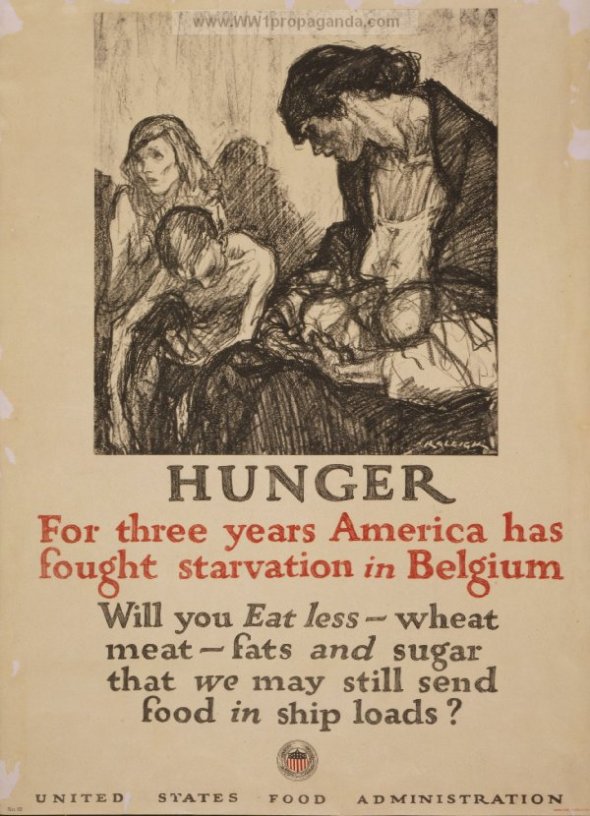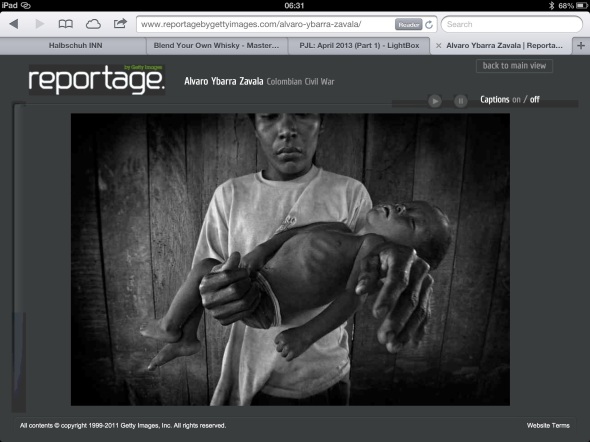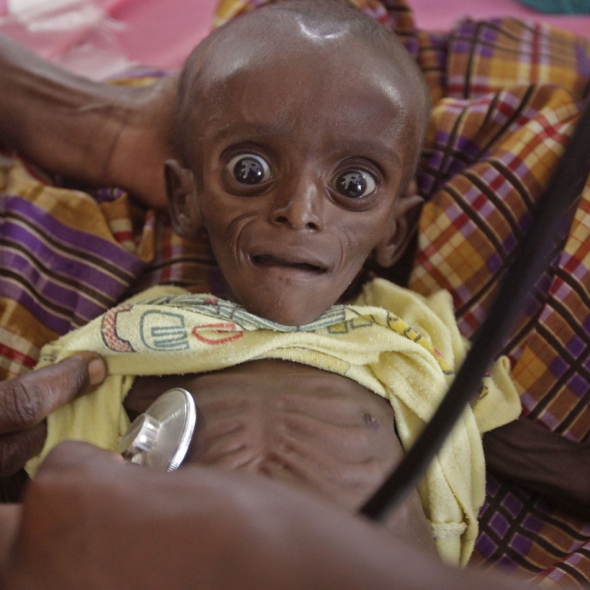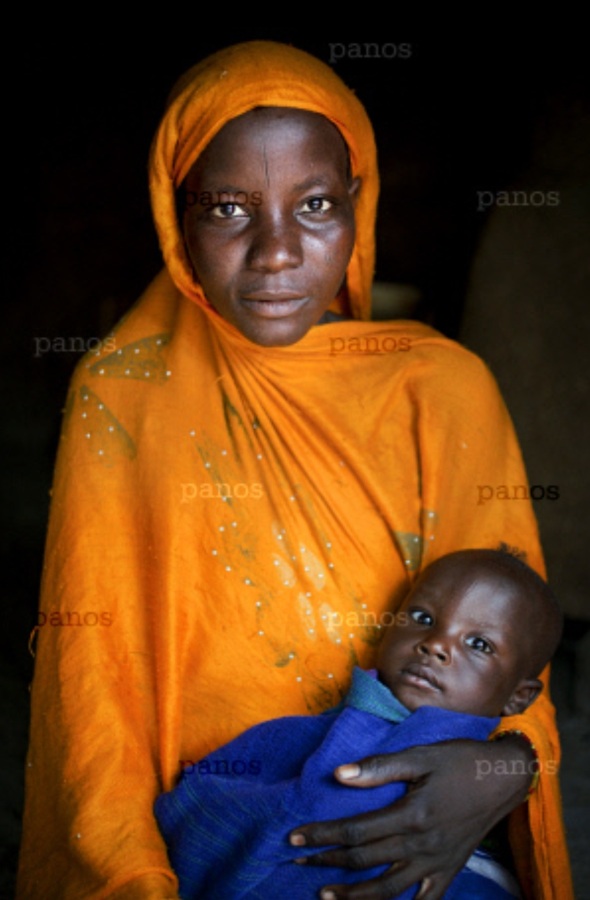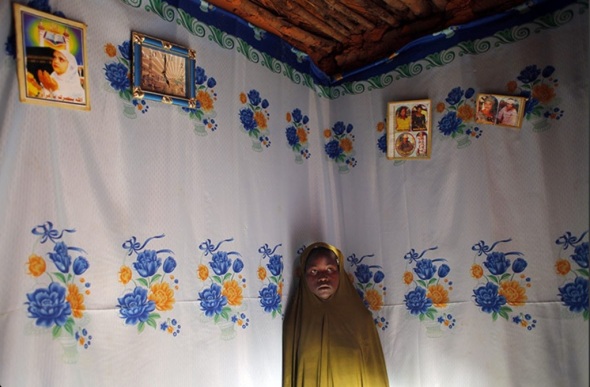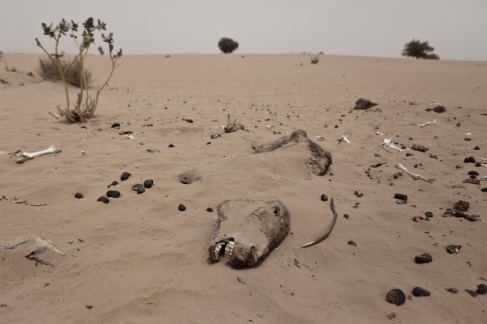American WW1 Propaganda Posters – Hunger
Hunger – For three years America has fought starvation in Belgium Will you eat less wheat, meat, fats and sugar that we may still send food in ship loads?. LOC Summary: Poster showing starving women and children. LOC Notes: No. 12. Date Created/Published: Chicago : Edwards & Deutsch Litho. Co., 1918. World War One poster provided by LOC. Original medium: 1 print (poster) : lithograph, color ; 74 x 54 cm. link
Colombia civil war and hunger
COLOMBIA – NOVEMBER 2007: A father displays the body of his dead son in his arms. Fighting in the area meant that the child could not be evacuated from the village for medical treatment, so died of hunger and diarrhea. The presence of the different active armed groups within local communities is one of the main reasons for the displacement of civilians. (Photo by Alvaro Ybarra Zavala/Edit by Getty Images)
The 45 Most Powerful Images Of 2011
This picture is named the 30th most powerful
Mihag Gedi Farah, a seven-month-old child, is held by his mother in a field hospital of the International Rescue Committee in the town of Dadaab, Kenya. The baby has since made a full recovery.
Niger: Tackling Life-Threatening Malnutrition
When her small twins Ousseina and Alassane got thinner and thinner, their mother Zali brought them to the local health centre in the small village of Grado in Niger. Both twins were suffering from severe acute malnutrition, which can be fatal if left untreated. Photo Copyright S.Hauenstein Swan
The Ladies of Guera
Like much of the Sahel, Chad’s Guera region is experiencing another bout of an all too familiar phenomenon: severe drought, food shortages, hunger and chronic malnutrition. Up to 18 million people across the Sahel are facing a severe food crisis and 1 million children could be affected by severe, acute malnutrition.
Droughts are by no means new in this part of the world and have been occurring cyclically since the 17th century but as Professor Marc Bellemare at Duke University in North Carolina points out “food crises rarely, if ever, occur because of an overall lack of food to go around.” Instead, “poor infrastructure and conflict combine to create the perfect storm of constraints to food imports and food distribution” and a steep increase in population over the past two decades is exacerbating the problem.
Abbie Trayler-Smith
Niger’s hunger brides
Niger has one of the highest child marriage rates in the world, according to Unicef. On average, one in three girls marries before her 15th birthday – and severe drought, poverty and hunger are pushing some parents to marry off their daughters at even younger ages.
A Syrian boy
A Syrian boy, who fled his home with his family due to fighting between government forces and rebels, holds a plate with food to eat at a refugee camp near the Turkish
Manu Brabo—AP
Yida refugee camp flooded with North Sudanese
Getty Images reports: Yida refugee camp in South Sudan grows each day and now has swollen to 64,317, as the refugees continue to flee from South Kordofan in North Sudan. The numbers of refugees arriving from North Sudan vary from 500 to 1,000 a day.
Many new arrivals walked from 3 to 5 days to reach the camp without food. The rainy season has increased the numbers suffering from diarrhea and severe malnutrition and 95% of the field hospitals’ patients are children under the age of five. link
From war zones, photographer brings scars and searing images
Sebastian Rich has covered every major war and conflict of the past 30 years. He has been wounded several times, kidnapped and held hostage while on assignment as a photographer and television cameraman.
Children in Conflict, an exhibition at the National Press Club in Washington, D.C., is showcasing a selection of images from Rich’s career alongside a new body of work produced for the United Nations High Commission for Refugees. The new collection illustrates the plight of Afghan refugees in the Jalozai refugee camp in Pakistan.
A terribly malnourished Afghan baby boy in a UNICEF Therapeutic feeding center in Herat, Afghanistan. His fate is unknown to me. link
Hunger is most urgent threat to children worldwide
For the first time in a decade, the number of children suffering from hunger and malnutrition has risen, threatening the substantial progress made in child health and education in the developing world.
Famine, by Radhika Chalasani
‘To this day, I think I didn’t necessarily do the right thing’
Some photographers and journalists have a very absolute point of view that you never interfere, because your job is as an observer and you can do the most good by remaining one. I decided a long time ago that I had to do what I could live with in terms of my own conscience, so when it felt appropriate to try to do something, I would. There are certain situations you struggle with. We’re interfering with a situation by our very presence, and that automatically changes the dynamic. At one point, I was photographing a woman carrying her son into a feeding centre. He was extremely malnourished, and I was photographing her as she walked along. All of a sudden, these Sudanese people started directing her for the photos. They had her sit down and were indicating how she should hold her child. I ran to get a translator, and said, “Tell her to take her child to the feeding centre. She should not be stopping because I’m taking a photograph.”
Another time, there was a family sitting under a tree just outside the feeding centre, about 10 feet away. But they couldn’t walk, they were so emaciated. And there was a group of photographers all around them. I took a few pictures, but then I walked into the feeding centre and asked a nurse, “Is there anything you can do for this family?”
I’ve been in situations where it’s been a hard call, though. On one occasion, a group of photographers went into an abandoned refugee camp and found a massacre site. There were some children who had survived. There were two baby twins in a hut: I tried to get one child to take my hand and realised it had been chopped off. We didn’t know how long they had been there. And it’s in the middle of a civil war, so you’re not sure how safe things are.
Myself and another photographer wanted to take the kids out of there in the car. Several of the other people didn’t think it was safe, in case we got stopped at a checkpoint, and they wanted to get back for their deadlines. In the end, we didn’t take the children. We found the Red Cross and reported the situation to them, but I found that another photographer went there the next day and found another child who was a survivor. To this day I think that I didn’t necessarily do the right thing.
I do believe that our main contribution is trying to get the story understood. And sometimes, when you think you’re helping, you’re actually making a situation worse. But, for me, you try to do what you can live with.
Niger: Habou’s story
the stroy of a little boy, in niger, and his home in niger. how he is found ill with malnutrition and how he is getting treatment from Save the Children link
Niger Revisiting an Unfinished Crisis
Seasonal hunger in the Sahel has once again escalated into a major food crisis. In Niger, shortfalls in food production, rising food prices and on-going poverty have pushed tens of thousands of families into food insecurity and thousands of children are suffering from severe acute malnutrition. copyright http://www.sambronx-photo.ch Samuel Hauenstein Swan link
Mourning in Mogadishu
Photographer Jared Moossy traveled to Somalia this September, photographing a country ravaged by famine. He visited two refugee camps, near Bald Hawa and Dolo, and the capital, Mogadishu. What he saw — and what he photographed — was a country ravaged by decades of war, drought, and terrorism.
Above, women in Bald Hawa, gather to express their frustration and tell their stories — where they had traveled from, why they had left — while waiting for a food aid to be delivered. Several people in the group had walked for days to reach the refugee camp; many had lost family members along the way. link
Mauritania’s parched earth
By Susana Vera
There’s one thing I always do upon returning from a work trip. As soon as I leave my camera bag and suitcase on the floor I jump into the shower. I like having the water run down my face for a few minutes. I find it both relaxing and cleansing.
I never think much about how much water I’m using, I just tell myself that I “need” it, that I have a “right” to indulge after a long journey. I play around with the water temperature until I get it to that state where it’s neither too hot, nor too cold. After I finish, I head to the kitchen and make myself some food. That’s the same thing I did two days ago when I returned from Mauritania. But contrary to my habit in theses circumstances, I took a navy shower. I let the water run down my body just long enough to rinse the shampoo and soap off. The whole process took less than two minutes. Ten days in drought-stricken Mauritania photographing people rationing every bit of this precious and scarce resource are responsible for that change of heart.
Finding water and food to feed their families are the two main concerns of the population in Mauritania’s southern Gorgol region. What used to be the breadbasket of the country has, since the 1970′s, been significantly affected by climate change, causing a decrease in agriculture and the intensification of desertification. This has resulted in the exodus of many men from their villages to urban areas or even abroad to find jobs to support their families.
SLIDESHOW: MAURITANIA WAITS FOR RAIN
Women, the elderly and children have been left behind to work their land and care for their livestock. But that’s a very difficult mission when water supplies are running low due to severe rainfall deficit. If it does not rain soon, most crops and animal pasture will be lost and access to food for poorer families will become almost impossible.
Chad – a week’s food
Adjitti Mahamat ,40, cooks the one big meal a day for as many as ten children, including Kadija Ahmat 2, (on her back). Kassira Village, Guera province, Chad. 13/2/12 read on what is on the menu for the rest of the week
Food and nutrition crisis in Sahel region of Africa
A potentially catastrophic food crisis in the Sahel region of West and Central Africa could affect as many as one million children. The food and nutrition crisis resulting from a severe drought, threatens the survival of an entire generation of children. Those children in eight countries – Burkina Faso, Chad, Mali, Mauritania and Niger, Cameroon, Nigeria and Senegal – are at risk of severe acute malnutrition. Sparse rainfall, poor harvests and rising food prices have left many vulnerable and weak, seeking medical attention. Sahel is one of the poorest regions in the world where children already face daunting odds of survival. The current crisis makes their survival even more tenuous. Associated Press photographer, Ben Curtis, documented the conditions in the region. — Paula Nelson (EDITORS NOTE: We will not be posting Monday, May 14) (32 photos total)
Dala in the Sahel belt of Chad
Ben Curtis—AP – April 20, 2012. A dead donkey lies partially covered by the wind-swept sand in an area of desert where villagers take dead animals to avoid the smell and potential for disease affecting them, near the village of Dala in the Sahel belt of Chad. read more
Sahel food crisis: Chadian women describe the hardships they face
In some parts of west Africa, water levels have become dangerously low and pastureland has disappeared. The UN estimates more than 13 million people are at risk of serious food shortages. Here, Chadian women in the Bahr-el-Ghazal and Guera provinces speak about the poor harvest over the last few years and the difficulties they have in feeding their children. Photographer Andy Hall link
Pakistan’s Hungry Children
Child malnutrition has reached emergency levels in Pakistan, particularly in Sindh province, where monsoon floods devastated the country’s poorest region for a second year running. It is the single biggest contributor to deaths amongst under-fives by increasing the risk of infection and retarding recovery from illnesses. It stuns both mental and physical growth and children’s future capacities, sapping the next generation’s ability to meet the demands of a country already facing a ever more unstable future. link
Uncovering the Sadness of Young Deaths
By ROD NORDLAND
KABUL, Afghanistan – Inside the family hut, only women and close male relatives were allowed to mourn over the body of the baby boy, Khan Mohammad, who had died earlier that morning.
‘A national shame’
Rajni, a severely malnourished 2-year-old girl, is weighed by health workers at the Nutritional Rehabilitation Center of Shivpuri district in the central Indian state of Madhya Pradesh, Feb. 1. India has failed to reduce its high prevalence of child malnutrition despite its economy doubling between 1990 and 2005 to become Asia’s third largest. A recent government-supported survey said 42 percent of children under age 5 are underweight – almost double that of sub-Saharan Africa – compared to 43 percent five years ago. The statistic – which means 3,000 children are dying daily due to illnesses related to poor diets – prompted Prime Minister Manmohan Singh to admit that malnutrition was “a national shame” and was putting the health of the nation in jeopardy.
Adnan Abidi / Reuters
TURKANA DRAUGHT BY ÅSA SJÖSTRÖM
Piringan village in Turkana. ..Five million Kenyans are affected by the famine and draught. Kenya is the forgotten country on the horn of Africa..Southern Kenya is famous for a massive tourist industry with green landscape, snowy mountains, rich wildlife and crystal sandy beaches. The northern part is the opposite. The north is hardly hit by the draught and the villages are isolated with no roads connected to the bigger towns. The Turkana region is inhabited by pastoralists and the people…more
Combating drought in the Horn of Africa
Drought continues to threaten the lives of as many as 13 million people living in the Horn of Africa and many are struggling to continue their pastoral lifestyle. Photographer Alejandro Chaskielberg has been to the region for Oxfam who are are running a number of aid projects that offer long-term support to those in need.

